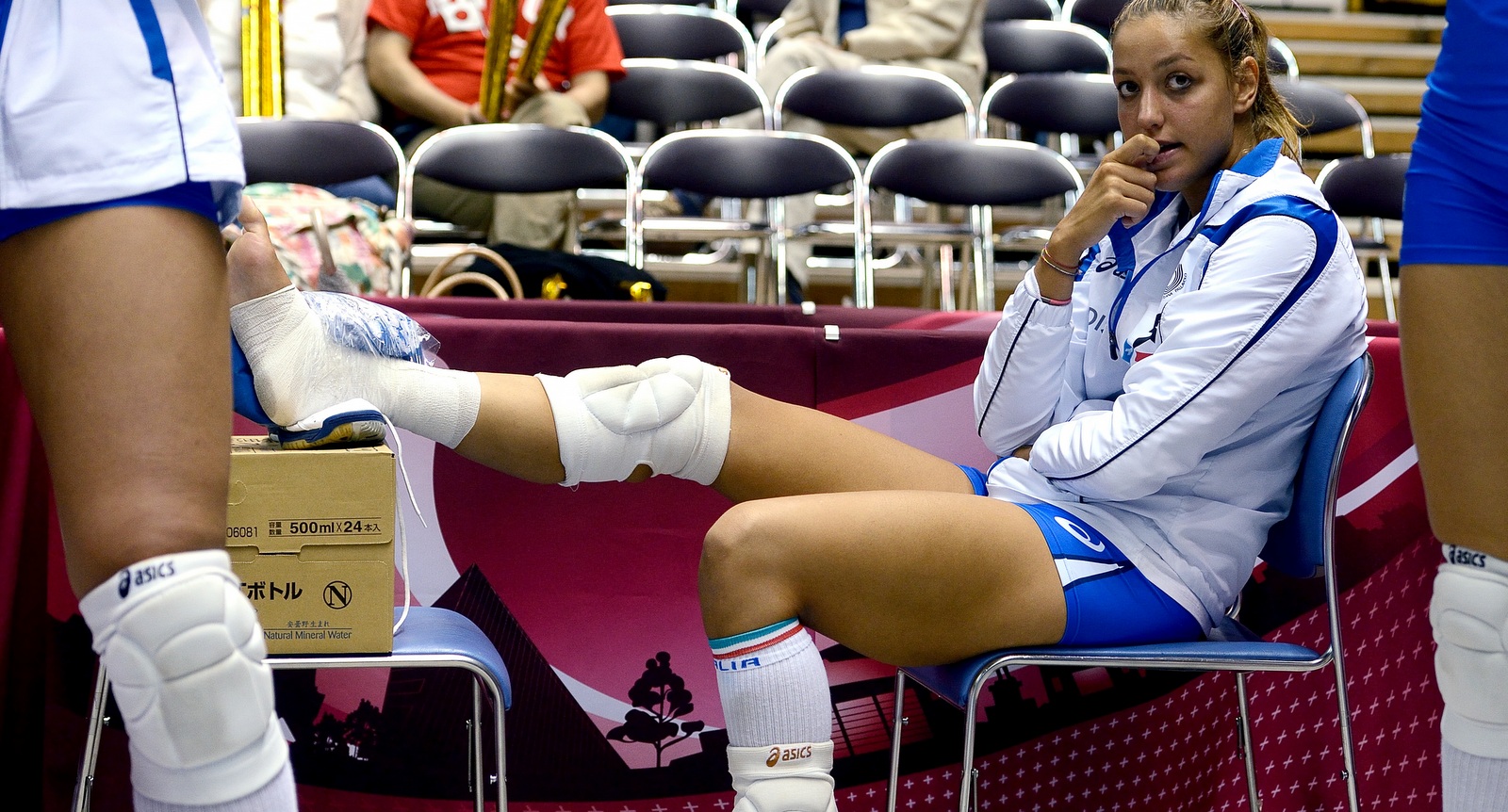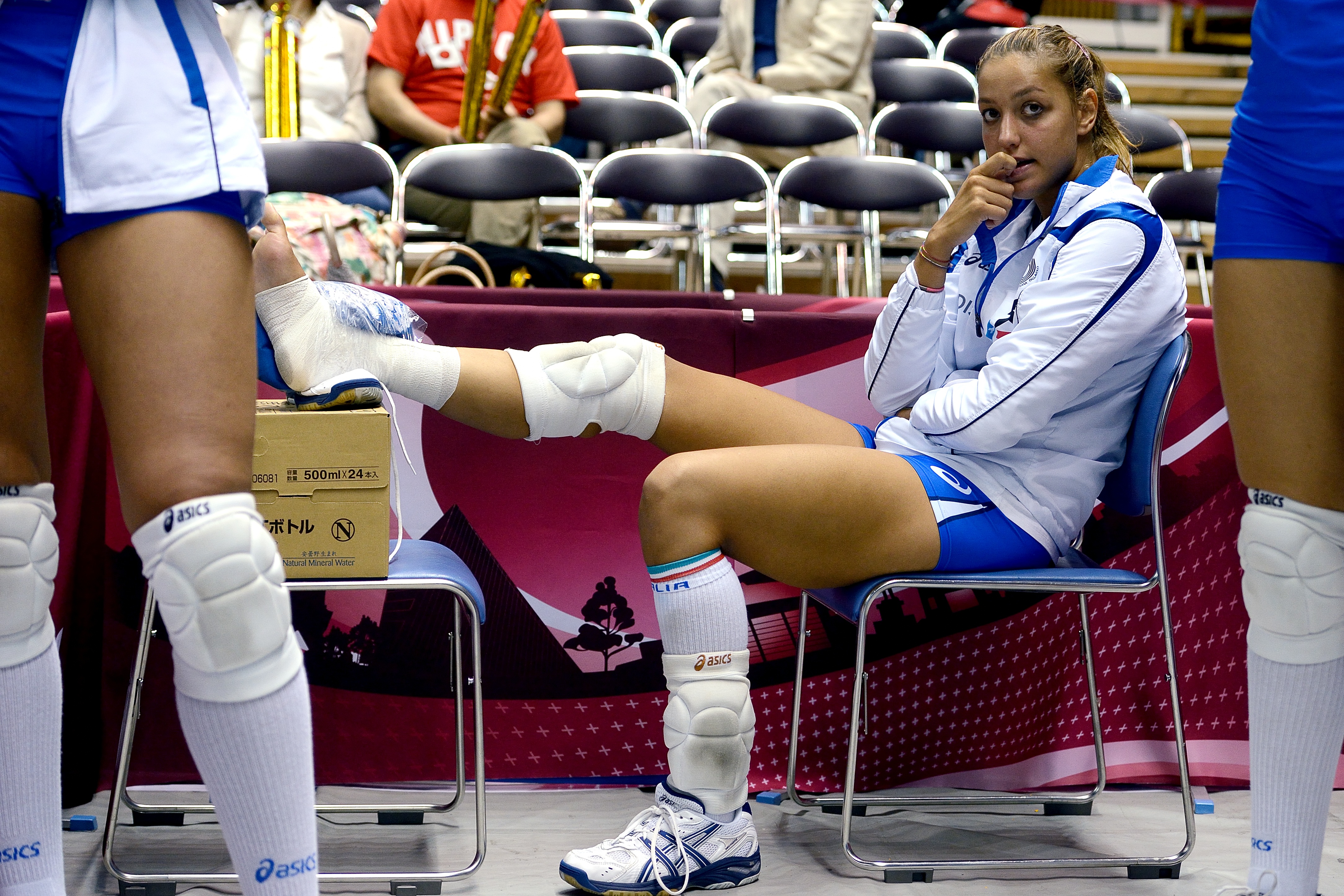FIVB Medical Commission medical@fivb.org
Principles of Prevention and Treatment of Common Volleyball Injuries
Jonathan C. Reeser, MD PhD
Roald Bahr, MD PhD
Injuries are, regrettably, an unavoidable hazard of sports participation. Although volleyball and beach volleyball are by most estimates relatively safe sports – particularly in comparison to other sports such as football (soccer) – epidemiologic research has revealed that volleyball athletes are at risk for certain types of injuries. Serious injuries which interfere with the athlete’s ability to participate have obvious immediate consequences (time lost from training and competition) and may have long term implications as well (chronic disability and functional limitation). Coaches and trainers should therefore have an understanding of the most common volleyball-related injuries in order to appreciate the potential impact injuries may have on the both on the athlete and the team.
One of the first considerations in discussing the injuries for which volleyball athletes are at risk is to define what constitutes an injury. One accepted definition used in research is that an injury is any condition for which an athlete seeks medical attention. Injuries so defined may in turn be further subdivided into conditions that result in “time lost” from either competition or training and those that do not limit playing time. The length of time loss (typically reported in days or weeks) therefore provides a measure of injury severity that can be used to compare different types of injury. For example, in their 2004 study chronicling the injuries that occurred during one volleyball season in the Dutch professional league, Verhagen et al determined that shoulder injuries resulted in an average time lost from training or competition of 6.5 weeks – by far the longest mean absence from participation compared to other injury sites documented in their study.
Injuries are also commonly categorized by and compared based upon the body part affected (e.g. shoulder, knee, ankle, lower back). One additional useful classification criterion is whether the athlete was injured as the result of acute tissue overload or whether the injury resulted from chronic overuse.
Acute injuries, such as ligament sprains and muscle strains, occur when the limits of tissue distensibility and integrity are suddenly overwhelmed. The athlete is usually able to recall an exact mechanism of injury to correspond to the sudden onset of pain and functional limitation. In contrast, overuse injuries (e.g. tendinopathies) often occur insidiously. As a result the injured athlete often cannot recall a specific traumatic incident or a definite mechanism of injury. A hybrid of these two injury mechanisms occurs when tissue that has been weakened from overuse suddenly fails in response to an acute load. The athlete will identify the moment of “injury”, but may not appreciate the impact of the chronic tissue overload that predisposed him (or her) to ultimately develop outright tissue failure.
Numerous studies reporting on injury patterns in volleyball have been published. Unfortunately, differences in the definition of injury and in calculation of incidence rates make it difficult (if not impossible) to directly compare these studies. Nevertheless, it is generally accepted that the most commonly occurring injuries are acute ankle sprains, followed by overuse conditions of the knee (patellar tendinopathy) and shoulder (multidirectional instability, impingement) and the lower back (nonspecific mechanical low back pain).
Acute Injuries – Ankle Sprains
Ankle sprains are clearly the most common volleyball-related injury, accounting for just over half of the acute injuries recorded prospectively by Bahr et al and Verhagen et al. Ankle sprains occur most frequently at the net when one player lands on another player’s foot, inverting the ankle and stretching (or tearing) the ligaments on the lateral (outer) aspect of the ankle. Athletes who have suffered an ankle sprain in the past are more likely to suffer a subsequent injury. If the injured player has difficulty accepting weight onto the involved ankle, or if bearing weight results in severe pain, she or he should not continue playing and should seek prompt medical attention.
The goal of initial treatment for ankle sprains (and for acute injuries in general) is to limit internal bleeding and swelling, and to provide an environment conducive to tissue healing. The acronym PRICE is easy to recall and nicely summarizes the early steps in caring for an acute ankle sprain.
PRICE stands for:
Protection – Protect the ankle from further immediate injury. Depending on the severity of the sprain, a period of immobilization and restricted weight bearing may be necessary. As the athlete’s condition improves, he or she may resume progressively more advanced activity patterns. However, use of an external support (brace, or taping) is generally recommended for the first six months following injury.
Rest – As mentioned, a period of restricted activity promotes early tissue healing. Weight-bearing may resume as symptoms subside, and activity may progress accordingly.
Ice – Application of ice (or other cryotherapy modality) provides analgesia and helps to minimize swelling. Although there is no consensus on treatment parameters, cold treatment is often applied for 20 minutes at a time (followed by 20 minutes without ice). Three such on/off cycles of cryotherapy may be administered in succession several times per day over the first 24 – 48 hours following the injury.
Compression – Temporary compression immediately following the injury limits swelling in the injured ankle, which in turn facilitates restoration of normal range of motion.
Elevation – Elevating the injured ankle also helps to minimize swelling immediately following the injury.
PRICE treatment should be initiated as quickly as possible following the injury (Figure 1). Acute injuries should also be promptly evaluated by a trained medical professional in order to carefully assess the extent and severity of injury, arrange for diagnostic testing as needed in order to arrive at an accurate understanding of the nature and extent of the injury, and formulate a definitive treatment plan. The athlete should be monitored carefully, and examined periodically to confirm that healing is progressing as expected. In addition to range of motion and strengthening exercises, the comprehensive treatment of ankle sprains should include instruction in a program of neuromuscular (proprioceptive) re-education. This involves having the athlete balance on the involved limb, limiting corrective motion to the involved joint to the extent possible (Figure 2). As the athlete improves, these balancing exercises should be made progressively more challenging (both in terms of duration, and in terms of adding unstable surfaces or other challenges to the maintenance of balance). Return to play decisions following an ankle sprain (or indeed any injury) should be guided by functional recovery rather than mere absence of pain. In their 2004 study, Verhagen et al documented that ankle injuries resulted in a mean of 4.5 weeks of time lost from training or competition.
Since ankle injuries are so common among volleyball players and result in considerable time loss, it makes sense to try to prevent them. Primary prevention entails practicing proper footwork at the net, integrating proprioceptive exercises into the athlete’s regular conditioning program, and consistent use of external ankle braces. Only recently has there been any evidence for a significant prophylactic effect from the use of semi-rigid external ankle orthoses (Figure 3) among volleyball players. Despite some concern voiced by coaches and athletes alike, there is no evidence in the literature to suggest that the use of ankle orthoses increases the risk of knee injuries. Another means of reducing the risk of ankle sprains would be to modify the existing centerline rule, which allows for a portion of the foot to penetrate onto the opponent’s court without a violation. While such rule changes have been discussed, it seems unlikely that any substantive modification of the centerline rule would be possible without significantly altering the dynamic aspects of the sport as it is currently played.
Overuse Injuries – Patellar Tendinopathy
Anterior knee pain represents the second most common diagnosis among volleyball athletes. The most common causes of anterior knee pain among volleyball players are patellofemoral syndrome, and patellar tendinopathy (also known as “jumper’s knee”). Both of these diagnoses represent overuse conditions. Fortunately, volleyball players appear to be at relatively low risk for acute knee problems, such as injury to the anterior cruciate ligament. Nevertheless, overuse conditions such as patellar tendinopathy can extract a very high cost in terms of loss of time, and may lead to chronic debilitating symptoms that adversely affect the athlete’s quality of life.
Unlike acute injuries, which have a distinct mechanism and time of onset, overuse injuries are insidious in nature. Athletes with overuse injuries generally cannot recall a specific moment when their injury occurred, but report instead a history of activity related discomfort that has become progressively more severe over time. Many athletes attempt to “play through” or compensate for the initial symptoms of overuse pathology, and only after the pain becomes limiting or the performance deficit intolerable will the athlete take time off from training or competition. Consequently, treatment of overuse injuries is often challenging. The first priority is to alter or minimize the load on the injured area. This is generally accomplished through activity modification. Reducing the load on the injured area allows the affected tissues an opportunity to recover and begin healing. However, in order to adequately treat an overuse injury, it is important to examine the athlete’s risk factors for injury.
Risk factors for injury (which can be defined as those qualities which increase the likelihood that an athlete will develop a certain type of injury), may be categorized as either “intrinsic” or “extrinsic” to the athlete, and as either “modifiable” or “unmodifiable”. Risk factors for jumper’s knee include the volume of jumping and jump training which the athlete must endure (extrinsic, modifiable), the biomechanics of the knee during the spike approach and upon landing from the jump (intrinsic, modifiable), and the composition of the surface on which the athlete trains and competes (extrinsic, modifiable). Ferretti and colleagues documented that hard, unforgiving surfaces increase one’s risk of developing jumper’s knee. Not surprisingly, therefore, jumper’s knee is less common among beach volleyball players than it is among indoor volleyball athletes. The amount of knee valgus stress on the lead (usually non-dominant) knee during the spike approach jump is a risk factor for developing patellar tendinopathy, as is the degree of knee flexion achieved during landing from the spike jump. Interestingly, those athletes who had the greatest jumping ability were found to be at the greatest risk for developing patellar tendinopathy. There are undoubtedly other genetic susceptibility factors involved in the pathogenesis of jumper’s knee, since not all athletes who undergo comparable jump training programs will develop symptomatic jumper’s knee.
Practical prevention strategies for jumper’s knee include strengthening and conditioning the muscles of thigh, hip, and buttocks so that they can effectively absorb the shock of landing from jump after jump. Analysis of technique is also important, as bending too deeply at the knees when landing from a jump, or excessively “toeing in” during the loading and take off phases of the jump can predispose the athlete to jumper¹s knee. Perhaps the most effective preventive intervention is simply reducing the load on the knee extensor mechanism by limiting the volume of jumping required during training sessions.
Even with an appreciation of some of the modifiable risk factors for anterior knee pain, effective treatment of jumper’s knee often remains elusive, further underscoring the importance of prevention.
Some athletes benefit from the use of an infra-patellar strap, which is thought to redistribute the traction force on the patellar tendon during activation of the quadriceps, thereby reducing the risk (or minimizing the symptoms) of tendinopathy. Eccentric quadriceps training (Figure 4, shown without the incline board that can be used to make the exercise more demanding) may be of some benefit as a pre-season conditioning exercise, but this type of exercise has not been shown to be effective in treating symptomatic patellar tendinopathy during the competitive season. Advances in our understanding of the underlying cellular and tissue pathophysiology have led to new methods to treat this condition, which at its worst can be potentially career-threatening. Among these treatments is sclerosis of neovessels under ultrasound guidance, which has been shown to be of some clinical benefit. Other less proven methods of treatment include injections with platelet rich plasma. Although thought to deliver concentrated growth factors and cellular mediators involved in tissue healing direct to the site of tissue injury, there is little scientific proof of the effectiveness this technique. Severe cases of patellar tendinopathy may require surgical intervention.
The Author: Jonathan Reeser, MD PhD is the past chair of the USA Volleyball Sports Medicine and Performance Commission, and a former member of the Medical Commission of the Federation Internationale de Volleyball (the International Federation governing the sports of volleyball and beach volleyball world-wide). He currently serves as a team physician for the USA Volleyball National Teams. He works at the Marshfield Clinic Research Foundation, and resides in Marshfield, Wisconsin with his wife and two sons.



One Comment
Leave a Reply